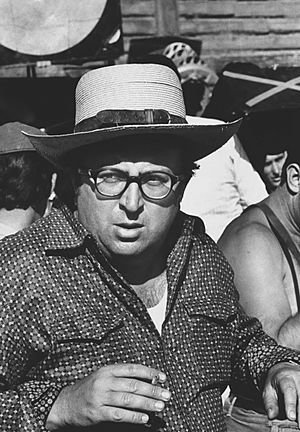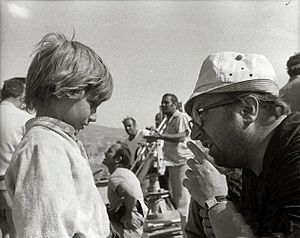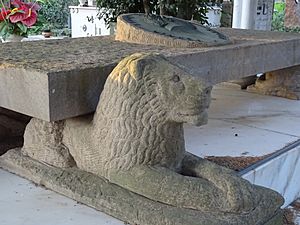Sergio Leone facts for kids
Quick facts for kids
Sergio Leone
|
|
|---|---|

Leone on the set of A Genius, Two Partners and a Dupe, 1975
|
|
| Born | 3 January 1929 Rome, Italy
|
| Died | 30 April 1989 (aged 60) Rome, Italy
|
| Resting place | Napoleonic Cemetery, Pratica di Mare, Pomezia, Italy |
| Occupation |
|
| Years active | 1948–1989 |
| Style | |
| Parents |
|
Sergio Leone (born January 3, 1929 – died April 30, 1989) was a famous Italian film director, producer, and screenwriter. He is known for creating the "Spaghetti Western" movie style. Many people see him as one of the most important directors in movie history.
Leone's movies often used a special style. He would show very close-up shots of faces, then suddenly switch to wide shots of the landscape. His most famous films include the Dollars Trilogy Westerns, which starred Clint Eastwood. These were A Fistful of Dollars (1964), For a Few Dollars More (1965), and The Good, the Bad and the Ugly (1966). He also made the Once Upon a Time films: Once Upon a Time in the West (1968), Duck, You Sucker! (1971), and Once Upon a Time in America (1984).
Sergio Leone's Early Life and Start in Movies
Sergio Leone was born in Rome, Italy, on January 3, 1929. His father, Vincenzo Leone, was a movie pioneer known as Roberto Roberti. His mother, Edvige Valcarenghi (Bice Valerian), was a silent film actress.
When he was a student, Leone was classmates with Ennio Morricone for a while. Morricone later became a famous composer who wrote music for many of Leone's films. After watching his father work on movie sets, Sergio Leone started his own film career at age 18. He had left his law studies at the university to do this.
He began working in Italian cinema as an assistant. His first job was helping Vittorio De Sica make the movie Bicycle Thieves in 1948. In the 1950s, Leone started writing screenplays. He mostly wrote for "sword and sandal" movies, which were historical epics popular at that time.
Leone also worked as an assistant director on big international movies. These films were shot at the Cinecittà Studios in Rome and funded by American studios. Some of these movies included Quo Vadis (1951) and Ben-Hur (1959).
In 1959, director Mario Bonnard became sick while making The Last Days of Pompeii. Leone was asked to finish the film. This experience prepared him well for his first movie as a solo director, The Colossus of Rhodes (1961). He learned how to make low-budget films look like big Hollywood productions.
Sergio Leone's Film Career
The Rise of Spaghetti Westerns in the 1960s
In the mid-1960s, historical epic movies became less popular. Sergio Leone then turned his attention to a new type of film called the "Spaghetti Western." This style was inspired by American Western movies but made in Italy.
His film A Fistful of Dollars (1964) was based on a Japanese samurai movie called Yojimbo (1961) by Akira Kurosawa. Leone's film helped make Clint Eastwood a big star. Before this, Eastwood was mainly a TV actor.

A Fistful of Dollars showed a new, tougher vision of the American Old West. Leone's Westerns were different from traditional American ones. In older Westerns, heroes often wore white hats and villains wore black hats. Leone's characters were more realistic. They were often "lone wolves," looked dirty, and sometimes acted like criminals. They could also be kind or selfish, depending on the situation.
Leone's next two films, For a Few Dollars More (1965) and The Good, the Bad and the Ugly (1966), completed what is known as the Man with No Name trilogy. Each film was more successful than the last. These movies featured amazing music scores by Ennio Morricone, who worked closely with Leone. Clint Eastwood continued to star in these films, joined by actors like Eli Wallach and Lee Van Cleef.
Because of the success of the Man with No Name trilogy, Leone was invited to the United States. In 1967, he directed Once Upon a Time in the West for Paramount Pictures. This film was shot mostly in Spain and Rome, with some scenes in Monument Valley, Utah. It starred famous actors like Charles Bronson, Henry Fonda, and Claudia Cardinale.
Once Upon a Time in the West was a long, dreamlike movie about the myths of the American Old West. It was very violent but also beautiful. The film's story was written by Leone and his friend Sergio Donati, based on an idea by Bernardo Bertolucci and Dario Argento. Even though it was cut shorter for American audiences, it was a huge hit in Europe. Many people now consider it one of Leone's best films.
Directing and Producing in the 1970s

After Once Upon a Time in the West, Leone directed Duck, You Sucker! (1971). He originally planned only to produce it, but he ended up directing due to disagreements with the first director. This film was an action drama set during the Mexican Revolution. It starred James Coburn as an Irish revolutionary and Rod Steiger as a Mexican bandit.
Leone also continued to produce other films and sometimes helped reshoot scenes. One such film was My Name Is Nobody (1973), a comedy Western that made fun of the Spaghetti Western style. It starred Henry Fonda as an old gunslinger and Terence Hill as a young stranger.
Other movies Leone produced included A Genius, Two Partners and a Dupe (1975), The Cat (1977), and A Dangerous Toy (1979). He also produced three comedies directed by Carlo Verdone. In 1978, Leone was part of the jury at the 28th Berlin International Film Festival.
Final Film and Later Years in the 1980s
Sergio Leone turned down the chance to direct The Godfather. Instead, he spent ten years working on a gangster story he had thought of earlier. This project was based on a novel called The Hoods by Harry Grey. It was about a group of Jewish gangsters in New York City in the 1920s and 1930s who had been friends since childhood.
The finished film, Once Upon a Time in America (1984), was four hours long. It starred Robert De Niro and James Woods. The movie explored themes of greed, violence, friendship, and what it meant to be from a certain background in America. When it premiered at the 1984 Cannes Film Festival, it received a huge, long ovation.
However, Warner Brothers, the studio, thought the film was too long for the American market. They cut it down to two hours and changed its story structure. This shorter version received bad reviews and did not do well. The original, longer version was released in other parts of the world and later gained much praise when released on home video in the US. Many critics now call it a masterpiece.
Leone was very sad about the studio's changes and the film's poor reception in North America. Once Upon a Time in America was his last film. In 1988, he was the head of the jury at the 45th Venice International Film Festival.
Sergio Leone's Death
Sergio Leone died on April 30, 1989, at his home in Rome. He was 60 years old and died from a heart attack. He was buried in the cemetery of Pratica di Mare.
Movies Sergio Leone Planned But Never Made
Sergio Leone had several movie ideas that he never got to make.
A Place Only Mary Knows
This was a Western story set during the American Civil War. It was about a Union soldier and a shady Southern businessman searching for buried treasure. Leone wanted to explore themes from classic American writers. His son later published the story idea in an Italian movie magazine.
Leningrad: The 900 Days
Leone was very interested in a book about the Siege of Leningrad during World War II. He planned to make a big war movie about it. The story would follow an American photographer who gets trapped in Leningrad during the siege. Leone wanted Robert De Niro to play the main character. He had secured half of the money needed for the film, but he died two days before he was supposed to sign the final agreement.
Don Quixote
Leone thought about making a modern version of the classic novel Don Quixote. He imagined Clint Eastwood as Don Quixote and Eli Wallach as Sancho Panza.
Colt
In 1987, Leone had an idea for a TV miniseries called Colt. It would follow a Colt revolver as it passed from owner to owner throughout the Old West. He wanted to show the Old West more realistically than in his earlier films. This project was put aside for A Place Only Mary Knows, but the idea is now being adapted by another Italian filmmaker.
Other Film Ideas
Leone was a big fan of the novel Gone with the Wind. He often talked about making a new film version that was closer to the book. He also considered adapting the novel Journey to the End of the Night and directing the film Flash Gordon, but these plans never happened.
Awards and Honors
Sergio Leone received several awards and honors for his work:
- David di Donatello
- 1972: Won for Duck, You Sucker!
- British Academy of Film and Television Arts – Award for Best Direction
- 1984: Nominated for Once Upon a Time in America
- Golden Globe Award for Best Director
- 1984: Nominated for Once Upon a Time in America
He also received the America Award from the Italy-USA Foundation in 2014, after his death.
Sergio Leone's Main Films
Here are some of Sergio Leone's most well-known films that he directed:
| Year | English Title | Italian Title | Notes |
|---|---|---|---|
| 1961 | The Colossus of Rhodes | Il Colosso di Rodi | |
| 1964 | A Fistful of Dollars | Per un pugno di dollari | Part of the Dollars Trilogy |
| 1965 | For a Few Dollars More | Per qualche dollaro in più | |
| 1966 | The Good, the Bad and the Ugly | Il buono, il brutto, il cattivo | |
| 1968 | Once Upon a Time in the West | C'era una volta il West | Part of the Once Upon a Time Trilogy |
| 1971 | Duck, You Sucker! | Giù la testa | |
| 1984 | Once Upon a Time in America | C'era una volta in America |
Actors Who Worked Often with Sergio Leone
Some actors appeared in many of Sergio Leone's films:
|
Work
Actor
|
|||||||
|---|---|---|---|---|---|---|---|
| The Colossus of Rhodes | A Fistful of Dollars | For a Few Dollars More | The Good, the Bad and the Ugly | Once Upon a Time in the West | Duck, You Sucker! | Once Upon a Time in America | |
| Roberto Camardiel | |||||||
| Clint Eastwood | |||||||
| Lee Van Cleef | |||||||
| Gian Maria Volonté | |||||||
| Mario Brega | |||||||
| Joseph Egger | |||||||
| Antonio Casale | |||||||
| Aldo Sambrell | |||||||
| Benito Stefanelli | |||||||
| Antonio Molino Rojo | |||||||
| John Frederick | |||||||
| Antoñito Ruiz | |||||||
| José Terrón | |||||||
| Al Mulock | |||||||
| Lorenzo Robledo | |||||||
| Frank Braña | |||||||
| Luigi Pistilli | |||||||
| Claudio Scarchilli |
See also
 In Spanish: Sergio Leone para niños
In Spanish: Sergio Leone para niños





